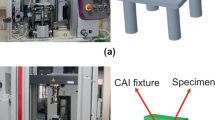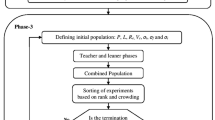Abstract
Randomly oriented chopped glass fiber reinforced polymer (ROCGFRP) composite laminate exhibits better flexural behavior, intended to use in various industrial applications such as aerospace, automobile, defence and marine engineering industries. This work employs the artificial neural network (ANN) model to predict the flexural strength of the randomly oriented chopped glass fiber composite beam using MATLAB\(^{\circledR }\)2021a. For this purpose, experimental flexural strength test based on ASTM D790 and finite element analysis (FEA) simulation with cohesive zone model using ANSYS Workbench 19.2 were conducted to compute the input and output parameters for the ANN model. Strain and stress datasets were chosen as the model’s input and output parameters, respectively. The entire datasets i.e., seven thousand six hundred and sixteen points, were divided into training, validation and test sets in the proportion of 70:15:15, respectively. The appropriate structure of the ANN model such as input layer, hidden layer, output layer, activation functions and training algorithm are selected and evaluated using statistical tools. The number of neurons in the hidden layer is optimized using Levenberg-Marquardt training algorithm. The training, validation and test components are fitted along the regression line, which shows strong relationship between analysis and desired outcomes. Thus, it is observed that, there is a high level of consistency is observed among the numerical, experimental and predicted results. Finally, the obtained ANN model is good predictor for flexural strength of ROCGFRP composite laminate.
















Similar content being viewed by others
Abbreviations
- ANN:
-
Artificial neural network
- BP:
-
Back-propagation
- CZM:
-
Cohesive zone method
- FE:
-
Finite element
- FEA:
-
Finite element analysis
- GFRP:
-
Glass fiber reinforced polymer
- GRNN:
-
Generalised regression neural network
- L–M:
-
Levenberg–Marquardt
- PVA:
-
Poly-vinyl alcohol
- PLA:
-
Polylactic acid
- QN:
-
Quasi Newton
- RBP:
-
Resilient back propagation
- RBFNN:
-
Radial basis function neural network
- RMS:
-
Root mean square
- ROCGFRP:
-
Randomly oriented chopped glass fiber reinforced polymer
- SVM:
-
Support vector machine
- UTM:
-
Universal testing machine
- VLRBP:
-
Variable learning rate back propagation
References
Jones RM (2018) Mechanics of composite materials. CRC Press, London
BK Chaurasia, D Kumar, and MK Paswan (2022) Experimental studies of failure in l-shaped carbon fiber-reinforced polymer composite under pullout and four-point bending. J Inst Eng (India): Ser D, pp. 1–11
Elkazaz E, Crosby W, Ollick A, Elhadary M (2020) Effect of fiber volume fraction on the mechanical properties of randomly oriented glass fiber reinforced polyurethane elastomer with crosshead speeds. Alex Eng J 59(1):209–216
Peret T, Clement A, Freour S, Jacquemin F (2017) Effect of mechanical states on water diffusion based on the free volume theory: Numerical study of polymers and laminates used in marine application. Compos B Eng 118:54–66
Kootsookos A, Mouritz AP (2004) Seawater durability of glass-and carbon-polymer composites. Compos Sci Technol 64(10–11):1503–1511
Lau K-T, Hung P-Y, Zhu M-H, Hui D (2018) Properties of natural fibre composites for structural engineering applications. Compos B Eng 136:222–233
Prakash C, Sekar KV (2018) 3d finite element analysis of slot milling of unidirectional glass fiber reinforced polymer composites. J Braz Soc Mech Sci Eng 40(6):1–13
Shenoi R, Dodkins A (2000) Design of ships and marine structures made from frp composite materials. Comprehen Compos Mater 6:429–449
Park S-J, Seo M-K (2011) Interface science and composites, vol 18. Academic Press, London
Seghi RR, Sorensen JA (1995) Relative flexural strength of six new ceramic materials. Int J Prosthodont 8:239–239
P Chaupal and D Kumar (2022) Progressive damage analysis of random oriented chopped glass fiber-reinforced laminate under three-point bending test. J Inst Eng (India) Ser D pp. 1–14, 2022
Ramnath BV, Elanchezhian C, Jeykrishnan J, Ragavendar R, Rakesh P, Dhamodar JS, Danasekar A (2018) Implementation of reverse engineering for crankshaft manufacturing industry. Mater Today Proc 5(1):994–999
Hartsuijker C, Welleman J (2007) Shear forces and shear stresses due to bending, Engineering mechanics: stresses. strains, displacements, pp 271–409
Chaudhary S, Singh K, Venugopal R (2018) Experimental and numerical analysis of flexural test of unfilled glass fiber reinforced polymer composite laminate. Mater Today Proc 5(1):184–192
G. Rathnakar and H. Shivanan (2013) Experimental evaluation of strength and stiffness of fibre reinforced composites under flexural loading. Int J Eng Innov Technol (IJEIT) vol. 2, no. 7
Galhano GÁ, Valandro LF, De Melo RM, Scotti R, Bottino MA (2005) Evaluation of the flexural strength of carbon fiber-, quartz fiber-, and glass fiber-based posts. J Endodont 31(3):209–211
El-Wazery M, El-Elamy M, Zoalfakar S et al (2017) Mechanical properties of glass fiber reinforced polyester composites. Int J Appl Sci Eng 14(3):121–131
Cavalcanti D, Banea M, Neto J, Lima R, Da Silva L, Carbas R (2019) Mechanical characterization of intralaminar natural fibre-reinforced hybrid composites. Compos B Eng 175:107149
Dong C (2020) Flexural properties of symmetric carbon and glass fibre reinforced hybrid composite laminates. Compos Part C Open Access 3:100047
Jiang X, Song J, Qiang X, Kolstein H, Bijlaard F (2016) Moisture absorption/desorption effects on flexural property of glass-fiber-reinforced polyester laminates: Three-point bending test and coupled hygro-mechanical finite element analysis. Polymers 8(8):290
Cheng P, Peng Y, Wang K, Wang Y-Q (2021) Mechanical performance and damage behavior of delaminated composite laminates subject to different modes of loading. J Braz Soc Mech Sci Eng 43(10):1–10
Wang S-C (2003) Interdisciplinary computing in Java programming, vol 743. Springer, Cham
Jiang Z, Gyurova L, Zhang Z, Friedrich K, Schlarb AK (2008) Neural network based prediction on mechanical and wear properties of short fibers reinforced polyamide composites. Mater Des 29(3):628–637
Chiachio M, Chiachio J, Rus G (2012) Reliability in composites-a selective review and survey of current development. Compos B Eng 43(3):902–913
Ranković V, Grujović N, Divac D, Milivojević N (2014) Development of support vector regression identification model for prediction of dam structural behaviour. Struct Saf 48:33–39
H Tanyildizi (2018) Prediction of the strength properties of carbon fiber-reinforced lightweight concrete exposed to the high temperature using artificial neural network and support vector machine. Adv Civ Eng
Zhang Z, Friedrich K (2003) Artificial neural networks applied to polymer composites: a review. Compos Sci Technol 63(14):2029–2044
Mentges N, Dashtbozorg B, Mirkhalaf S (2021) A micromechanics-based artificial neural networks model for elastic properties of short fiber composites. Compos Part B Eng 213:108736
Hassan AKF, Mohammed LS, Abdulsamad HJ (2018) Experimental and artificial neural network ann investigation of bending fatigue behavior of glass fiber/polyester composite shafts. J Braz Soc Mech Sci Eng 40(4):1–10
Vineela MG, Dave A, Chaganti PK (2018) Artificial neural network based prediction of tensile strength of hybrid composites. Mater Today Proc 5(9):19908–19915
Stephen C, Thekkuden DT, Mourad A-HI, Shivamurthy B, Selvam R, Behara SR (2022) Prediction of impact performance of fiber reinforced polymer composites using finite element analysis and artificial neural network. J Braz Soc Mech Sci Eng 44(9):1–11
P Chopra, RK Sharma, and M Kumar (2016) Prediction of compressive strength of concrete using artificial neural network and genetic programming. Adv Mater Sci Eng
Koker R, Altinkok N, Demir A (2007) Neural network based prediction of mechanical properties of particulate reinforced metal matrix composites using various training algorithms. Mater Des 28(2):616–627
Shmueli G, Bruce PC, Yahav I, Patel NR, Lichtendahl KC (2017) Data mining for business analytics: concepts, techniques, and applications in R. Wiley, London
Pazhamannil RV, Govindan P, Sooraj P (2021) Prediction of the tensile strength of polylactic acid fused deposition models using artificial neural network technique. Mater Today Proc 46:9187–9193
Kumar CS, Arumugam V, Sengottuvelusamy R, Srinivasan S, Dhakal H (2017) Failure strength prediction of glass/epoxy composite laminates from acoustic emission parameters using artificial neural network. Appl Acoust 115:32–41
Lucon PA, Donovan RP (2007) An artificial neural network approach to multiphase continua constitutive modeling. Compos B Eng 38(7–8):817–823
Ootao Y, Tanigawa Y, Nakamura T (1999) Optimization of material composition of fgm hollow circular cylinder under thermal loading: a neural network approach. Compos B Eng 30(4):415–422
Livingstone DJ (2008) Artificial neural networks: methods and applications. Springer, Cham
Hossain MS, Ong ZC, Ismail Z, Noroozi S, Khoo SY (2017) Artificial neural networks for vibration based inverse parametric identifications: a review. Appl Soft Comput 52:203–219
Carden EP, Fanning P (2004) Vibration based condition monitoring: a review. Struct Health Monit 3(4):355–377
Worden K, Dulieu-Barton JM (2004) An overview of intelligent fault detection in systems and structures. Struct Health Monit 3(1):85–98
Hakim S, Razak HA (2014) Modal parameters based structural damage detection using artificial neural networks-a review. Smart Struct Syst 14(2):159–189
Antsaklis PJ et al (1990) Neural networks for control systems. IEEE Trans Neural Networks 1(2):242–244
Getahun MA, Shitote SM, Gariy ZCA (2018) Artificial neural network based modelling approach for strength prediction of concrete incorporating agricultural and construction wastes. Constr Build Mater 190:517–525
Hagan MT, Menhaj MB (1994) Training feedforward networks with the Marquardt algorithm. IEEE Trans Neural Netw 5(6):989–993
Zakaria Z, Isa NAM, Suandi SA (2010) A study on neural network training algorithm for multiface detection in static images. Int J Comput Inf Eng 4(2):345–348
Chng E, Chen S, Mulgrew B (1996) Gradient radial basis function networks for nonlinear and nonstationary time series prediction. IEEE Trans Neural Netw 7(1):190–194
MH Beale, MT Hagan, and HB Demuth (1992) Neural network toolbox user’s guide. The MathWorks Inc, vol. 103
Beale MH, Hagan MT, Demuth HB (2010) Neural network toolbox. User’s Guide, MathWorks 2:77–81
Mousavi MV, Khoramishad H (2019) The effect of hybridization on high-velocity impact response of carbon fiber-reinforced polymer composites using finite element modeling, Taguchi method and artificial neural network. Aerospace Sci Technol 94:105393
Waseem M, Kumar K (2014) Finite element modelling for delamination analysis of double cantilever beam specimen. Int J Mech Eng 1(5):27–34
I ASTM (2007) Standard test methods for flexural properties of unreinforced and reinforced plastics and electrical insulating materials. ASTM D790–07
Harper L, Ahmed I, Felfel R, Qian C (2012) Finite element modelling of the flexural performance of resorbable phosphate glass fibre reinforced pla composite bone plates. J Mech Behav Biomed Mater 15:13–23
Author information
Authors and Affiliations
Corresponding author
Additional information
Technical Editor: João Marciano Laredo dos Reis.
Publisher's Note
Springer Nature remains neutral with regard to jurisdictional claims in published maps and institutional affiliations.
Rights and permissions
Springer Nature or its licensor (e.g. a society or other partner) holds exclusive rights to this article under a publishing agreement with the author(s) or other rightsholder(s); author self-archiving of the accepted manuscript version of this article is solely governed by the terms of such publishing agreement and applicable law.
About this article
Cite this article
Chaupal, P., Rajendran, P. Flexural strength prediction of randomly oriented chopped glass fiber composite laminate using artificial neural network. J Braz. Soc. Mech. Sci. Eng. 45, 131 (2023). https://doi.org/10.1007/s40430-023-04061-9
Received:
Accepted:
Published:
DOI: https://doi.org/10.1007/s40430-023-04061-9




